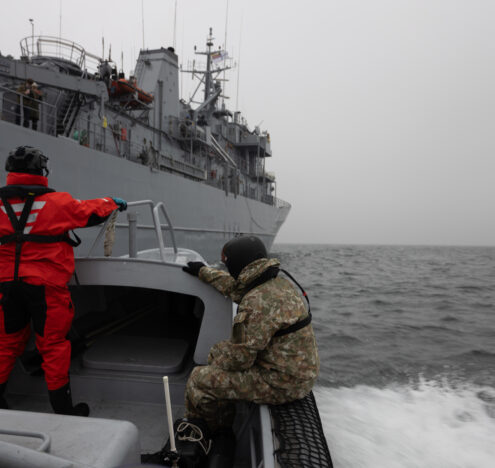This analysis was featured in Critical State, a weekly newsletter from Inkstick Media and The World. Subscribe here.
Even as the European Union and the United States continue to sanction Russia for its invasion of Ukraine, some economic exchange remains untouched. Germany continues to buy natural gas from Russia, citing domestic need. While Germany is not a direct party to the war, it has shipped weapons to Ukraine following the invasion, while at the same time funding Russia through gas purchases.
It is an odd state of affairs, but not unprecedented. In a paper published in International Security last summer, Marija Grinberg examines the commercial policy of the British Empire during World War I, to better understand how and why countries trade with their enemies in war.
Countries have to balance meeting existing domestic needs with the concern that they are supplying enemies with militarily useful goods — and this has a temporal dimension.
“Britain continued to trade with its enemies until October 1, 1918 — one month and eleven days before the Armistice,” writes Grinberg. “In fact, Britain started the war with restrictions on the export of only 20 percent of the goods that it ultimately prohibited from reaching the enemy. Even after a year of fighting, by the end of August 1915, around half of the products that would eventually be prohibited were still allowed to be legally traded with enemy states.”
To understand why countries will trade goods when they are trading blows, Grinberg suggests countries have to balance meeting existing domestic needs with the concern that they are supplying enemies with militarily useful goods. This has a temporal dimension: The longer countries are at war, the more they will restrict trade, as a way of reducing the capacity of enemies to convert that trade into useful military tools.
The most immediate example would be a prohibition on selling guns to the enemy at the outbreak of war, but as the war drags on, this might expand to include the material components for making guns and ammunition, and eventually to include tertiary economic activity that could be used to buy the material for making guns from elsewhere.
Secondly, Grinberg argues that the durability of trade with foes in wartime suggests that the existence of economic interdependence between countries might just mean trade continues during war, rather than the loss of trade ties being seen as a factor limiting the likelihood of war. Cutting off trade from an enemy carries with it the hardship of denying the benefits of that trade to one’s own nation, which can impact everything from material on hand to tax revenues.
One way this theory can be observed in practice is in the British government’s handling of machine guns at the start of WWI.
“Interestingly, machine guns were not prohibited from trade at the beginning of the war, as there was a wide consensus that they were useful only in wars of attrition, not in maneuver warfare,” writes Grinberg. “ Thus, carriages and mountings for machine guns were forbidden from export at the start of the war, but not machine guns themselves.”
Export of British machine guns to Germany was banned on Feb. 3, 1915, at the same time that the government prohibited the sale of heavy machinery for digging trenches and fortifications. The nature of the war, as well as the change in expectations of how quickly it could be won, changed trade policy.
This durability of trade despite the existence of a shooting war suggests that trade ties alone are not much of a deterrent to future wars, especially not between major powers. Smaller states, dependent on one large neighbor, would suffer disproportionately from a halt in trade if they launched a war against that larger neighbor, though it’s the same to consider smaller states already deterred from a war of aggression by the imbalance in strength.
In this, we can riff on Thucydides: During war the strong will trade what they can, and the weak will purchase what they must.




















